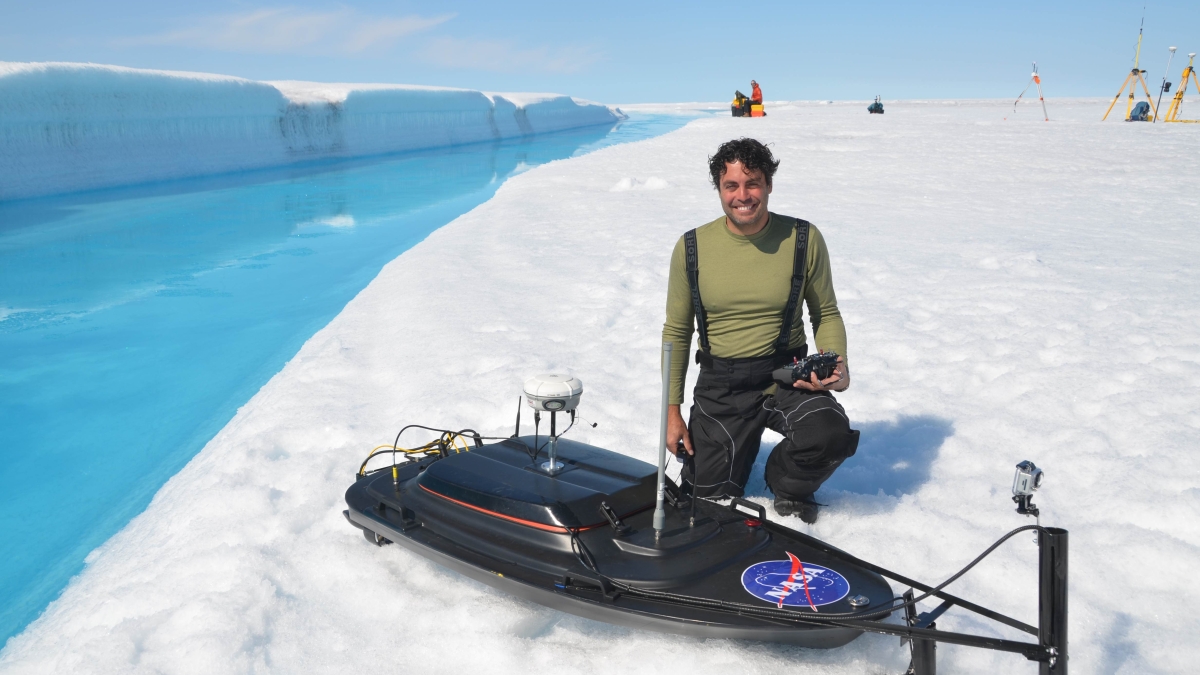Celebrating the life of professor Alberto Behar

Alberto Behar, a research professor at Arizona State University who has been operating, designing, building, testing and deploying scientific instruments and robotics in extreme environments for more than 20 years, died Jan. 9, when the plane he was flying crashed north of Los Angeles. He was 47.
Behar possessed an inquisitive mind. He was passionate. He was driven. He was an explorer. He was widely known for his energy, enthusiasm and technical excellence. He brought an optimism and an accompanying smile to even the most tense moments during difficult research projects.
“Alberto Behar was a uniquely talented engineer, developing ways to measure changes in our natural world in the most challenging environments – the ocean depths or the Antarctic ice cap,” said Lindy Elkins-Tanton, director of the School of Earth and Space Exploration at ASU. “With those around him, he shared both a brilliant mind and a big heart: his students were full partners in a grand adventure. His colleagues quickly came to know his caring nature and irrepressible good humor. We will all miss him tremendously.”
Today, much scientific exploration in extreme environments on Earth and in space is done using mobile robots. Behar dedicated his career to better understanding Earth and beyond by developing instruments that allowed for exploration of regions too dangerous or inaccessible for human explorers.
Behar had once said that new innovations are a way of overcoming the limits on our ability to explore: “Technology is how we get our senses to a remote location where we can’t actually go ourselves.”
During the course of his career, Behar developed instruments and robotics that have reached deep into the ocean's hydrothermal vents, next to volcanoes, under thick ice sheets, into the stratosphere and onto other planetary bodies. He participated in the exploration of Mars, serving as the Investigation Scientist for both the Dynamic Albedo of Neutrons (DAN) instrument on the Curiosity rover and the High Energy Neutron Detector on the Mars Odyssey orbiter.
A Greenland research paper, of which Behar was an author, was released today by the Proceedings of the National Academy of Science. The lead author Laurence Smith of UCLA contacted PNAS and asked to have the research dedicated to the memory of Behar. The Acknowledgments section will now begin with: "This research is dedicated to the memory of Dr. Alberto Behar, who tragically passed away January 9, 2015."
The life of an explorer
Behar’s parents emigrated from Cuba to the United States. Behar was born and raised in Miami, Florida, and attended the University of Florida, majoring in computer and information engineering sciences.
He went on to earn a master's of engineering in electrical, computer and systems engineering from Rensselaer Polytechnic Institute and a master's of science in computer science, with a specialization in robotics, from University of Southern California. In 1998, he obtained his doctorate in electrical engineering (astronautics minor) from the University of Southern California in Los Angeles.
Before coming to ASU in 2009, Behar spent 18 years at NASA’s Jet Propulsion Lab (JPL) operating, designing, building, testing and deploying scientific instruments and robotics in extreme environments.
“From his submarines that peeked under Antarctica to his boats that raced Greenland's rivers, Alberto's work enabled measurements of things we'd never known,” said Thomas Wagner, the Cryosphere Program Scientist at NASA Headquarters. “His creativity knew few bounds.”
Training the next generation
Behar was one of the first of a new breed of faculty to join the School of Earth and Space Exploration, according to Kip Hodges, founding director of the school. He was a researcher and educator who actively bridged the gap between science and engineering.
“From the moment he began working toward becoming part of our community, Alberto showed a natural affinity for working with undergraduates through project-based learning, and he became a tremendous mentor,” Hodges said. “To him, engineering was an enabling strategy for scientific research, and his enthusiasm for the field was extremely inspirational for many ASU students, not just those with majors in our school.”
Behar’s colleague Jack Farmer, a professor in ASU’s School of Earth and Space Exploration, describes him as “an engineer par excellence” with an amazingly diverse experience designing and testing robotic platforms for the exploration of extreme environments on Earth and, ultimately, other planets.
“He brought this amazing experience, along with his infectious enthusiasm for exploration, to the classroom and SESE students were clear beneficiaries,” said Farmer. He and Behar served together on the MSL team, and shared many experiences during the first 90 days of the mission, as they lived and worked on Mars time.
A passion for life
Behar was deeply passionate about exploration and discovery, and he was highly successful in his career, but he never lost sight of his true love: his family.
“When he wasn't talking about work, he was talking about his wife and children. He absolutely adored them,” said Jim Crowell, who had been working for Behar as a researcher after graduating from the School of Earth and Space Exploration. “He told me to focus on my life and having a family. As much fun or important as a career seems, he understood that family and living life was much more important than anything else.”
Behar is survived by his wife, Mary, and their three children: his son, Indra, and daughters, Isis and Athena.
Friends, colleagues and students agree that Behar was a man of science, with a passion for sharing knowledge and exploring the unknown.
“I once asked him what the purpose of one of our projects was,” recalls Crowell, “and he said simply: ‘Because we don't know.’ He was truly the embodiment of exploration.”

